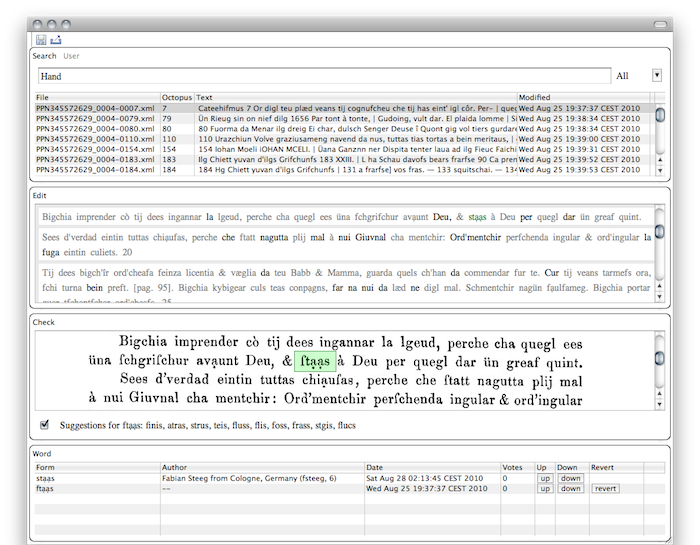fsteeg.com
| notes
![]() | tags
| tags
∞ /notes/scala-object-persistence-and-the-original-nosql-xml | 2010-08-30 | programming eclipse java xml scala
Scala, object persistence, and the original NoSQL: XML
Cross-posted to: https://fsteeg.wordpress.com/2010/08/30/scala-object-persistence-and-the-original-nosql-xml/
In our digitization wiki project based on Eclipse 4 and Scala it was time to find a persistence solution. As a quick overview of what it's about, our app will basically allow a user to edit a digitized book page, showing the original scan as an image, with the selected word highlighted. It currently looks like this: For the initial prototype implementation, we used XML files in zips to store the page content, combined with TrueZIP, a library which allows access to files in zips the way it should be: like files in a folder. So we could basically create and use the zip entries like this:
For the initial prototype implementation, we used XML files in zips to store the page content, combined with TrueZIP, a library which allows access to files in zips the way it should be: like files in a folder. So we could basically create and use the zip entries like this:
val zipEntry = new File("PPN345572629_0004.zip/0001.xml")def toXml:Elem = <page> { words.map(_.toXml) } </page>def fromXml(page:Elem) = Page( for(word <- (page \ "word"))
yield Word.fromXml(word) )val bonifaci = for (page <- Pages; word <- Words;
if page.id === word.pageId && word.original === "Bonifaci")
yield (page, word)object Pages extends Table[(String, java.sql.Blob)]("pages") {
def id = column[String]("id", O PrimaryKey)
def image = column[java.sql.Blob]("image")
def * = id ~ image
}val bonifaci = for (page <- xml\"page"; word <- page\"word";
if (word\"@original").text == "Bonifaci") yield (page, word)val xmls:Option[List[Elem]] = Db.xml(collection)val imgs:Option[List[Array[Byte]]] = Db.bin(collection)val pages:List[Page] = for(page <- Db.xml(collection))
yield Page.fromXml(page)val bonifaci = for (page <- pages; word <- page.words;
if word.original == "Bonifaci") yield (page, word)